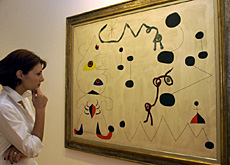Exhibition reveals why people collect art

Lugano's Museum of Modern Art is offering a rare opportunity to see classic artworks seldom seen in public.
The nearly 100 works range from Impressionist masterpieces to paintings by leading figures of classic modernism. All are on loan from private collections in canton Ticino.
Fourteen major collections – most of them little-known to the public – are represented in the exhibition, entitled “Passioni d’Arte – da Picasso a Warhol. Masterpieces of Ticino collections”.
In presenting them, the Lugano museum has set out to reveal the artistic tastes of the collectors, each of whom has his or her own room in the museum.
Some fascinating insights into their motivation in collecting works by – to name but a few – Pissarro, Degas, Picasso, Braque, Utrillo, Miró and Kandinsky are given by art history experts in the exhibition catalogue.
In an essay on 19th century collecting, Fernando Mazzocca says the term “collection” was coined relatively recently.
“It appeared significantly in the 1800s to cover and substitute older terms such as museum, studio and gallery,” he writes.
Private buyers
Mazzocca adds that these terms defined either the objects displayed or the building in which they were displayed, while in current usage a “collector” is usually a private individual who buys and accumulates objects.
“The motivation behind collections has given rise to many cultural, sociological and psychological comments,” says Mazzocca.
“Several basic reasons can be identified: aesthetic enjoyment, cultural stimuli, prestige, economic speculation and dedication.”
But although a profit motive is often present, the main spur to art collecting has proved to be cultural.
A story seldom told
In another essay, this time on the 20th century art market, Robert Brown says the story has seldom been told of the modern art market’s transformation from that of an elitist pastime for a few rich and dedicated patrons and collectors into that of a major cultural industry.
It is a story, he writes, largely dominated by the vital role played by American collectors in their early recognition and enthusiasm for European avant-garde art.
Further factors were “the replacement of Paris by New York as the new international centre of the art world and by the extraordinary explosion in the growth of the art market that took place in America in the 1960s which, by and large, still continues today.
“It is also a story about transformation. About how the dramatic rise in the art market has lead to the ‘commodification’ of art whereby a work of art has come to be seen by many people as less as an example of the artist’s vision and a part of his or her life’s work than as a national or cultural treasure.”
“Passioni d’Arte – da Picasso a Warhol. Masterpieces of Ticino collections” is in Lugano until December 8.
swissinfo, Richard Dawson
The exhibition features little-known works by the likes of Picasso, Pissarro and Degas, among others.
Its aim is to offers insights into why people collect art, and each collector has his or her own room in the museum.
The profit motive is seldom the primary reason for collecting.

In compliance with the JTI standards
More: SWI swissinfo.ch certified by the Journalism Trust Initiative
You can find an overview of ongoing debates with our journalists here. Please join us!
If you want to start a conversation about a topic raised in this article or want to report factual errors, email us at english@swissinfo.ch.